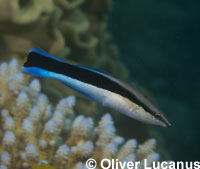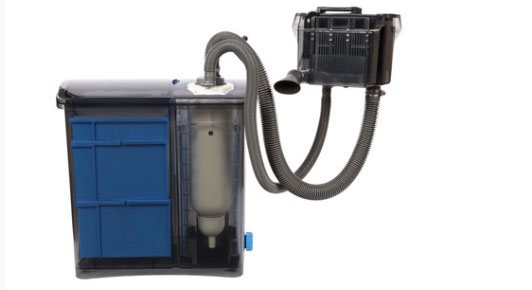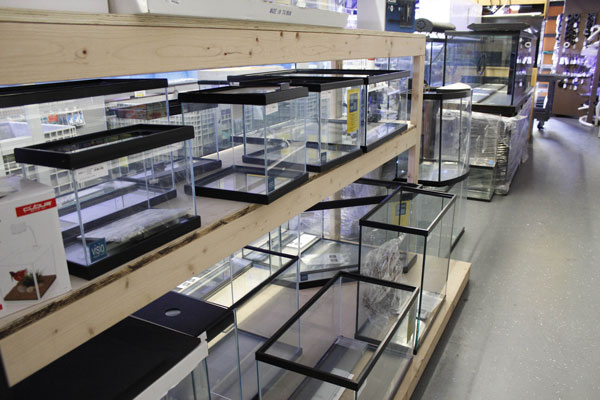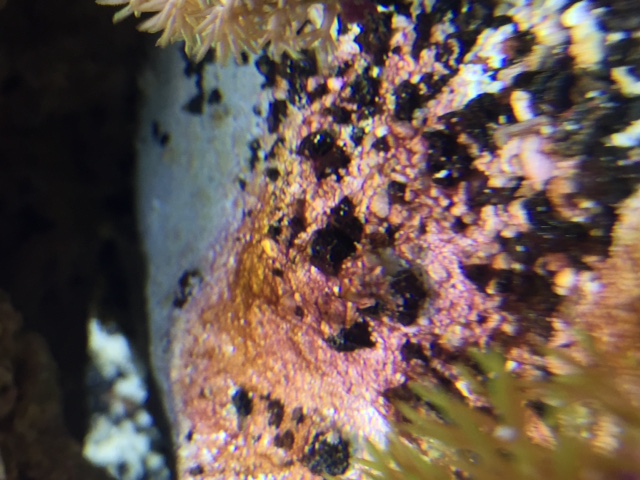
Efficient nitrogen cycle management is the secret of a successful aquarium. In aquatic ecosystems, tropical fish wastes and other organic matter undergo a biological process, the ultimate product of which is free nitrogen gas, the dominant component of the earth's atmosphere. Regrettably for aquarists, two of the intermediate products in this process, ammonia and nitrite, are quite toxic to tropical fish and other aquatic animals. These poisons tend to accumulate in a closed system, such as an aquarium, and once their concentrations exceed a certain level, mortalities in the aquarium are inevitable. Sound aquarium management is aimed at keeping ammonia and nitrite concentrations below this critical threshold.
Perhaps the most potent ally the aquarist can enlist in the campaign against toxic waste buildup is an efficient biological filter. A large and active community of nitrifying bacteria guarantees the swift conversion of ammonia to nitrite, which in turn is promptly oxidized to relatively harmless nitrate. Keep in mind, however, that even the most efficient biological filter does not completely free the hobbyist from the need to incorporate partial water changes into an aquarium maintenance program. On the other hand, a well-chosen, fully functioning biological filter can significantly reduce both the frequency and the volume of water that must be replaced to keep a given community of tropical fish healthy.
Due to significant promotional efforts in the early 1960s, "biological filtration" is virtually synonymous with "undergravel filter" to most aquarists. This is regrettable, because undergravel filters represent but one of many approaches to biological filtration. These units are reasonably priced and certainly work effectively under many circumstances. However, because they need an undisturbed layer of gravel over the filter plate to function properly, they cannot be used in aquariums housing tropical fish that root extensively in the substrate or dig actively. Nor are they the filter of choice for planted aquariums. Many aquatic plants do not seem to appreciate the water movement around their roots that results from waste-laden water being drawn through an aquarium's substrate. Finally, the action of any biological filter is seriously compromised by many widely used medications. Inasmuch as an undergravel system cannot be removed from the aquarium, it is impossible to prevent the undesirable effect of medication from affecting the nitrifying bacteria.
Because undergravel filters are so closely identified with biological filtration by most hobbyists, the limitations noted above have led some aquarists to conclude that biological filtration is not practical for some of their aquarium setups. Such a conclusion is quite unwarranted. There are many alternative approaches to biological filtration, a process that simply requires waste-laden water to move efficiently through a medium that is thoroughly colonized by nitrifying bacteria. Any reasonably porous material can serve as a filter bed. Perhaps the most versatile and efficient of these alternative approaches to biological filtration is the sponge filter.
As the name implies, such units employ a synthetic sponge as a substrate for nitrifying bacteria. The internal structure of this material provides these bacteria with an enormous area to colonize. A cylinder 2 inches in diameter and 6 inches long provides these organisms with living space equivalent to a gravel bed 1 inch deep and 3 feet square!
In its simplest version, a sponge filter uses a stream of air to create a current that pulls waste-laden water through a sponge mass. Here, metabolic wastes and suspended organic matter are broken down by nitrifying bacteria. More sophisticated units employ a rotary impeller drive to accomplish the same objective. A wide selection of air-driven sponge filters can be found on the market. The choice of dedicated power-driven units is smaller, but with a bit of ingenuity, one can successfully mate most air-driven units to many of the rotary impeller "power heads" designed to upgrade the performance of undergravel filters. It is thus possible to purchase or create sponge filters adequate to the needs of aquariums with capacities of 5 to 125 gallons.
When selecting a sponge filter, bear in mind that two factors determine operating efficiency. The first is the dimensions of the sponge mass. The greater the surface area exposed to water, the more effectively it will function. From this perspective, any unit that sits directly on the aquarium bottom has serious shortcomings. Quite simply, the underside is not pulling its weight.
The second consideration is the rate of flow through the sponge mass. Waste-laden water must come into contact with the filter bed's bacterial community for nitrification to occur. If the outer pores of a sponge are blocked by organic particulates or are overgrown with algae, flow is impeded and filter efficiency suffers. A sponge filter is thus not the ideal choice for heavily stocked aquariums or those housing tropical fish that produce a very heavy waste load.
Three decades of experimentation have left me with an unabashed preference for Tetra's line of sponge filters, which is not to say that other brands will not work. These are the only air-driven units on the market where the working surface of the sponge mass is proportional with its total surface area. The filters are designed to handle a range of aquarium capacities from 10 to 100 gallons. All of the larger units are easily mated with the several brands of rotary impeller-driven power heads on the market. This upgrades their capacity by as much as 50 percent.
The small and mid-range filters have the additional advantage of being the least obtrusive sponge filters on the market. It is thus a fairly simple matter to conceal their working parts from view in an aquascaped aquarium. The larger models pose a considerably greater challenge in this regard due to their greater bulk. They are thus more likely to find a place in working rather than decorative aquariums. Tetra sponge filters are somewhat more expensive, but I find the level performance well worth the additional cost.
Eheim, Rena, Sicce and Supreme all market very similar power-driven modular sponge filters. Sometimes marketed as submersible or internal power filters, these units house a hollow cylindrical sponge mass inside a flow-through plastic housing. A top-mounted rotary impeller pump pulls water through the sponge, whose central cavity can be filled with chemically active media. Return flow is regulated by a preset internal control. Efficient, externally mounted suction cups hold these reasonably unobtrusive corner units firmly in place against the aquarium wall.
These filters are absolutely silent and quite economical in their power consumption. The total working area of their sponge masses is much smaller than that of air-driven units. Their waste-handling capacity is thus proportionally smaller, which makes them a poor choice for heavily stocked aquariums.
The sealed-bearing motors of these filters use the aquarium's water as a coolant. As an unavoidable by-product of their operation, they thus generate a substantial amount of heat. I can attest from personal experience. As an example, a Rena model 325 can raise the temperature of a 15-gallon aquarium 3 to 5 degrees Fahrenheit above the heater setting. This is not necessarily a bad thing during the cooler months of the year, but it may prove troublesome during the summer. Manufacturer recommendations as to aquarium volumes appropriate for a specific model should thus be taken seriously! A further word of caution: Never run these units dry. Unless operated fully submerged, the motors of these filters will burn out in seconds.
The aerating effect of the normal return flow of both these units and the powerhead upgrades of more conventional sponge filters is nil. This can lead to problems is heavily planted aquariums. When the lights go off at night, aquatic plants become carbon dioxide producers rather than consumers and compete with tropical fish for available oxygen. It is thus prudent to take advantage of any aerating options a manufacturer may offer when purchasing such filters. If this is not practical, make some provision to provide supplementary aeration in the aquariums they service.
Unlike an undergravel filter, a sponge filter is completely mobile. It is thus possible to move a fully functional unit into a newly set-up aquarium, giving it the immediate benefit of biological filtration. This is the easiest way to avoid tropical fish losses due to "new aquarium syndrome," a catch phrase for deaths caused by short-term buildup of ammonia and nitrite that occurs before a biological filter is fully operational. Indeed, some progressive dealers offer fully mature sponges from their aquariums as part of a starter package for new customers. If more of their colleagues were to adopt this sensible practice, the drop-out rate among newcomers to the hobby would decline dramatically!
The mobility of sponge filters also makes it a simple matter to protect a sponge filter's nitrifying bacteria when an aquarium must be medicated. Simply move the filter to another aquarium or a bucket of water for the duration of the treatment. Once treatment is over, the sponge filter can be placed back in the aquarium, immediately restoring biological filtration.
Like other biological filters, these units require a sufficient population of nitrifying bacteria to function efficiently. As with undergravel filters, it requires a period of several weeks for a sponge to be fully colonized by nitrifying bacteria. This process can be greatly accelerated if the filter is initially installed in an established aquarium and then moved to its ultimate destination. With a bit of advance planning, one can have a functional biological filter ready for installation in a newly set-up aquarium. However, if one must start from scratch with a sponge filter, prudence dictates adding tropical fish to the aquarium a few at a time. This minimizes the likelihood that the initial population of nitrifiers will be confronted with a larger waste load than they can process.
A sponge filter is easily cared for. When its surface appears clogged or congested, or in the case of motor-driven units, if the sponge mass seems in the process of collapsing in upon itself and the return flow of water has fallen off, remove the unit from the aquarium and rinse the dirty sponge thoroughly. Squeeze the sponge until the water pressed from it runs perfectly clear. This can be done under a stream of lukewarm tap water if the filter was removed from a freshwate raquarium. A sponge filter from a marine aquarium should be rinsed with water of the same salinity and comparable temperature to avoid adverse physical effects on the nitrifiers, which would reduce the filter's operating efficiency. Do not rinse sponges under scalding hot water or soak them in permanganate or bleach solutions! These strong disinfecting agents will eradicate the bacterial flora, returning the filter to square one as far as effectiveness is concerned.
It should not be necessary to clean a sponge filter more than once a month. If its pores clog more frequently or are quickly overgrown with blue-green algae, the waste load of the aquarium is more than the unit's nitrifying bacteria can handle. An outside power filter can be used to trap particulate waste before it has a chance to clog the pores of a sponge filter, thus enhancing its operating efficiency and extending the interval between servicing. However, the only real solution to this problem is to reduce the waste load the unit must process. This can be done either by reducing the number of tropical fish present in the aquarium or installing additional filters.
Synthetic sponges are not immortal. Their bacterial colonists will eventually break down the sponge's molecular structure, leading to the loss of rigidity and necessitating replacement. In my aquariums, I find it necessary to replace sponges about every two years. Aquarists whose tropical fish produce a more modest waste load than the cichlid fish I am partial to might well get an additional year or two out of their sponges. An additional complication facing aquarists who opt for these filters is a well-documented penchant of some herbivorous species for munching on matured sponges. The loricariid catfish genera Panaque and Pterygoplichthys, both red-bellied and black pacus, Distichodus sexfasciatus, large tinfoil barbs and the cichlid fish Tilapia buettikoferi, Tilapia mariae, Tilapia zillii, Heros severus, Heros appendiculatus, Heros bifasciatus, Heros fenestratus, Heros maculicauda, Heros synspilus and Uaru amphiacanthoides have all been implicated in this bizarre behavior. Short of placing the sponge beyond their reach (e.g., on the other side of a coarse plastic grid or inside the plastic casing of a submersible power filter), there seems no way to assure the survival of sponges in the presence of these species.
The decision to invest in a sponge filter, and the choice of a specific brand and model, are obviously dictated by each hobbyist's particular circumstances. The point to be made here is that the availability of a wide selection of these versatile units places efficient, fully mobile biological filters at the disposal of anyone willing to take the time to install them. Given the importance of correct nitrogen cycle management to successful fishkeeping, few filtration systems give a better return on an aquarist's investment.
 Cleaner Wrasse
Cleaner Wrasse
 Useful Idea For Stronger Nutrition And Wellness
It truly does show when you take time to create a proper no
Useful Idea For Stronger Nutrition And Wellness
It truly does show when you take time to create a proper no
 Aquarium Filtration Done Right
Today, keeping unique aquatic species is now commonplace tha
Aquarium Filtration Done Right
Today, keeping unique aquatic species is now commonplace tha
 Five Tips for Freshwater Aquarium Success
You spent countless hours researching the latest products to
Five Tips for Freshwater Aquarium Success
You spent countless hours researching the latest products to
 Red Algae in Marine Aquarium
Q. Ive been keeping saltwater fish for about five years, and
Red Algae in Marine Aquarium
Q. Ive been keeping saltwater fish for about five years, and
Copyright © 2005-2016 Pet Information All Rights Reserved
Contact us: www162date@outlook.com